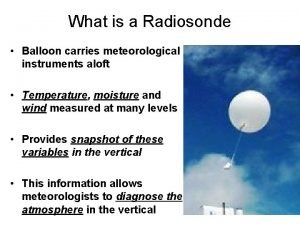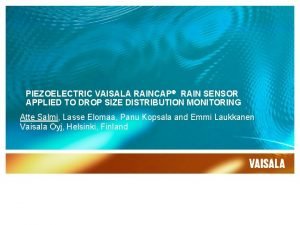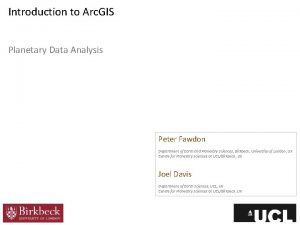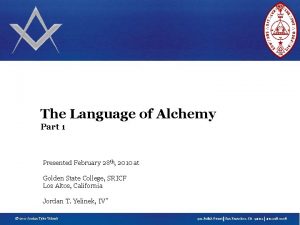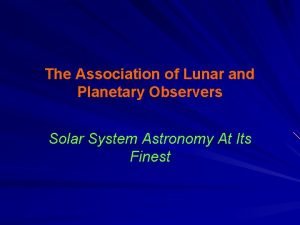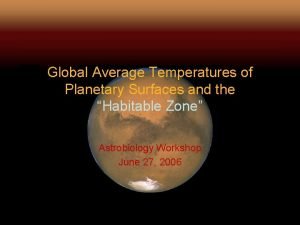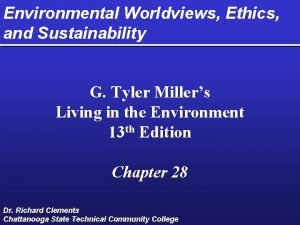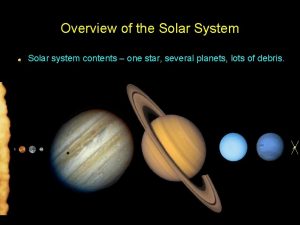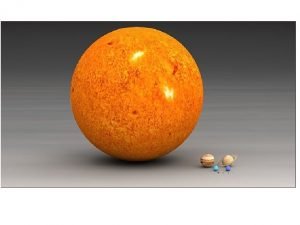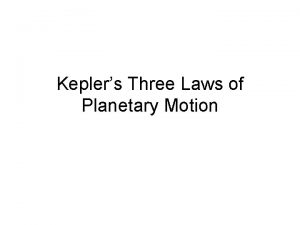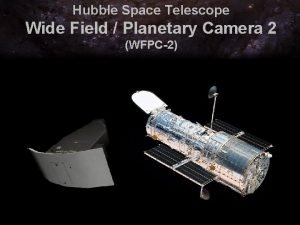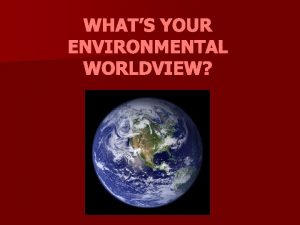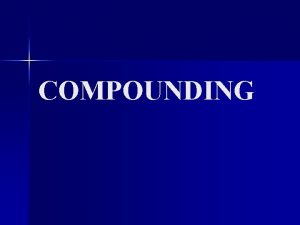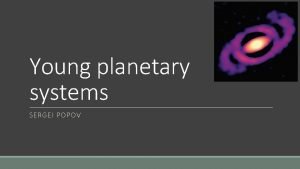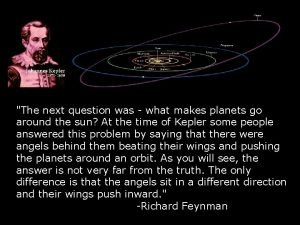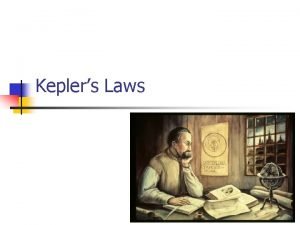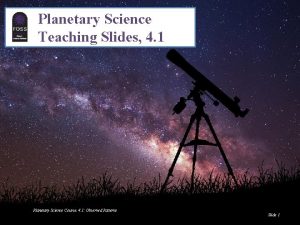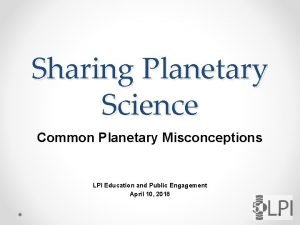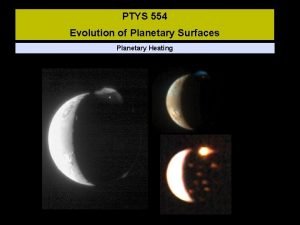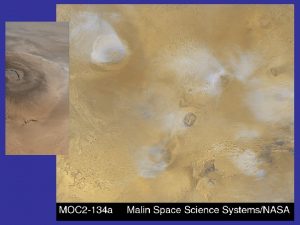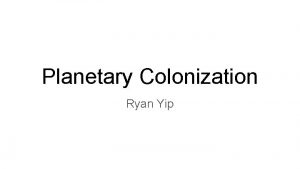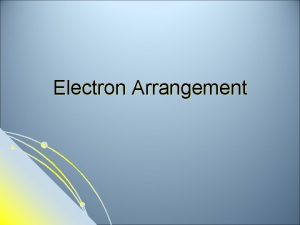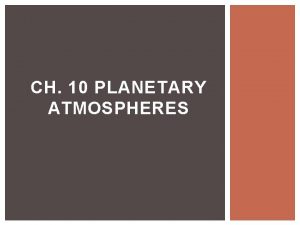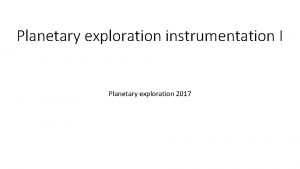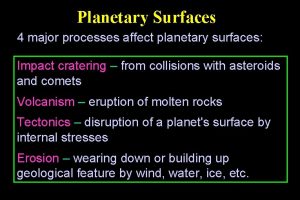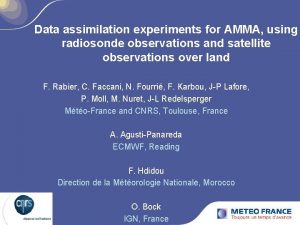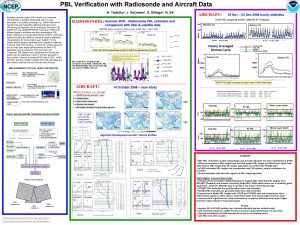The value of highresolution radiosonde data in Planetary

























- Slides: 25

The value of high-resolution radiosonde data in Planetary Boundary Layer Studies Dian Seidel NOAA Air Resources Laboratory College Park, Maryland With major contributions from Yehui Zhang Workshop on Research Applications of High-Resolution Radiosonde Data 27 -29 May 2013 Stony Brook University 1

Topics �Motivations for PBL studies �Suitability of raobs for PBL studies �Dependence of PBL parameters on vertical resolution �Effects of vertical resolution changes on apparent PBL trends 2

Motivations for PBL Studies �Importance of PBL processes in climate �Climate feedbacks involving surface fluxes �Carbon cycle �Vertical profile of temperature trends �Air quality applications �Limited observational analyses for model evaluation 3

Many Ways to Characterize the PBL �Thermodynamic profiles �Wind profiles �Derived quantities (incl. dimensionless ratios) �Inversions, inflection points, threshold values �Concentrations of trace constituents �Cloud bases, tops �Atmospheric turbulence parameters, surface roughness characteristics �Not all are measured by or derivable from raobs 4

PBL Heights Based on Vertical Profile Data � Sounding from Lerwick, UK 2300 UTC 23 December 2006 � Vertical profiles of 6 variables � Estimated PBL heights -- dashed horizontal lines � PBL height depends on selected variable, vertical resolution of data 5

Complex planetary boundary layer structures Height (m) 2000 Free Atmosphere Mixing Height Stable (Nocturnal) Boundary Layer 0 Noon Sunset Figure from Stull (1988) Midnight Local Time Sunrise Noon Surface-Based Inversion (SBI) 6

Global Radiosonde Network � Integrated Global Radiosonde Archive (Durre et al. 2006, Durre and Yin 2008 ) � 1999 -2008 data from 505 stations with � reasonably complete records (at least 50% of expected obs) � decent vertical resolution (min 10 levels between sfc and 500 h. Pa) � 44 U. S. stations with high (~35 m) resolution data 7

Effect of Sounding Vertical Resolution Max vert. pot. temp. gradient Elevated temperature inversion � 25 th, 50 th, and 75 th percentile values of PBL height using all soundings during 1999 -2007 from 44 stations �High (35 m) resolution data from SPARC Data Center �Standard resolution data from NOAA/NCDC/IGRA �We required 10 levels below 500 h. Pa; 6 are mandatory; soundings had 11 -34 8

Surface-Based Inversions (SBI) • SBIs are common in polar regions, wintertime • SBI Parameters: Sample temperature profile from Alert, Canada (82 N, 62 W) at 1200 UTC 14 February 2009 • Depth → ∆z • Intensity → ∆T • Sounding resolution determines • SBI top • Embedded layers • SBI identification may depend on location of surface observations ∆h → Embedded non-inversion layers 2/24/2021 Air Resources Laboratory 9

PBL Mixing Height 0000 UTC 28 June 2006 Minneapolis, Minnesota (45 N, 94 W) T RH θv Wind Speed Bulk Ri “Mixing Height” Note mismatch of wind and PTU data 10

Summertime Mixing Height Diurnal Cycle Radiosondes (2/day) superposed on ERA-Interim (8/day) 11

Sounding Resolution Affects SBI Characteristics 1983 Changes In Average Values 11 → 16 levels 16 → 25 % 456 → 131 m 2. 5 → 1. 2 K SBI characteristics at Jan Mayen, Norway (71 N, 9 W), 1963 -2009 1983 increase in vertical resolution of soundings 12

Suitability of Raobs for PBL Studies REPORT CARD Subject Measurement of relevant parameters Resolution of diurnal variations Spatial sampling of the globe Grade B D D Coincident surface and upper-air information Length of observational record Vertical resolution (and co-location of parameters) Homogeneity of data archive C A B to F C GRADE POINT AVERAGE ? 13

Value of High Resolution Raob Data �Better resolution of small-scale structures within the PBL, including cloud layers �More confidentification of surface-based inversions �Closer co-location of wind and temperature data allows more accurate calculation of Richardson number, etc. 14

Thank you! 15

Publications �Estimating climatological planetary boundary layer heights from radiosonde observations: Comparison of methods and uncertainty analysis. Seidel et al. (JGR 2010) �Climatological characteristics of Arctic and Antarctic surfacebased inversions. Zhang et al. (J. Climate 2011) �Challenges in estimating trends in Arctic surface-based inversions from radiosonde data. Zhang and Seidel (GRL 2011) �Climatology of the planetary boundary layer over the continental U. S. and Europe. Seidel et al. (JGR 2012) 16

Extras PBL 17

Daytime Summertime “Mixing Heights” ERA-Interim Reanalysis GFDL AM 3 Climate Model NCAR CAM 5 Climate Model Dots: Radiosonde Data 18

Obs/Model Comparisons: SBI Frequency in Winter • Similar spatial distributions (and seasonal patterns) • ERA-Interim agrees well with (assimilated) observations • Climate models underestimate SBI frequency • ERA-Interim shows higher Arctic Ocean SBI frequency than climate models 19

Trends in Arctic SBIs �Previous studies report inconsistent results for limited regions (Bradley et al. 1993, Walden et al. 1996, Kahl et al. 1996, Bourne et al. 2010) �Most ignore data homogeneity, so trends are suspect �Of 113 stations, we judged 19 homogeneous for 1990 -2009 20

Extras Tropopause 21

Trends in Tropical Cold-Point Tropopause �James S. Wang, Dian J. Seidel, and Melissa Free, 2012: How well do we know recent climate trends at the tropical tropopause? J. Geophys. Res. , 117, D 09118, doi: 10. 1029/2012 JD 017444. 22

Tropical average T near tropopause 70 h. Pa CPT 100 h. Pa �Cold Point Tropopause (CPT) and 70 and 100 h. Pa �Variations are similar �All show (real and/or spurious) cooling 23

Adjustments reduce 100 h. Pa cooling Unadjusted data in red � 5 approaches to removing time-varying biases �Cooling reduced, also at 70 h. Pa �Adjusted datasets only available for mandatory pressure levels, not CPT 24

Adjusted CPT Trends: Nearby Level Approach �Wide range of trends (uncertainty) �Adjustments reduce CPT cooling 25
 What is a radiosonde
What is a radiosonde Vaisala radiosonde price
Vaisala radiosonde price Planetary data analysis
Planetary data analysis Value creation value delivery value capture
Value creation value delivery value capture Alchemical language
Alchemical language Association of lunar and planetary observers
Association of lunar and planetary observers Prius planetary gear animation
Prius planetary gear animation Planetary temperature calculator
Planetary temperature calculator Human centered worldview
Human centered worldview Planetary systems
Planetary systems Planetary systems
Planetary systems Planetary positions today
Planetary positions today Kepler's three laws of planetary motion
Kepler's three laws of planetary motion Wide field and planetary camera 2
Wide field and planetary camera 2 Mars, jupiter, and saturn show retrograde motion because
Mars, jupiter, and saturn show retrograde motion because Which factor causes global wind patterns?
Which factor causes global wind patterns? Planetary management worldview definition
Planetary management worldview definition Law of planetary motion
Law of planetary motion Planetary mixer definition
Planetary mixer definition Environmental world view
Environmental world view Planetary model
Planetary model Planetary disc
Planetary disc Gravitational force images
Gravitational force images Planetary protection
Planetary protection Nasa planetary science
Nasa planetary science Kepler's law of planetary motion
Kepler's law of planetary motion
